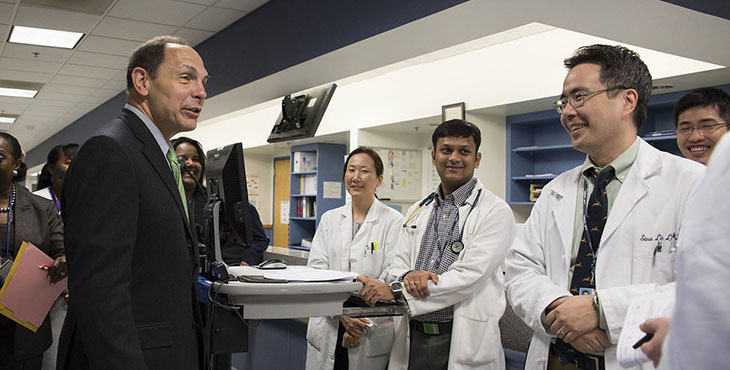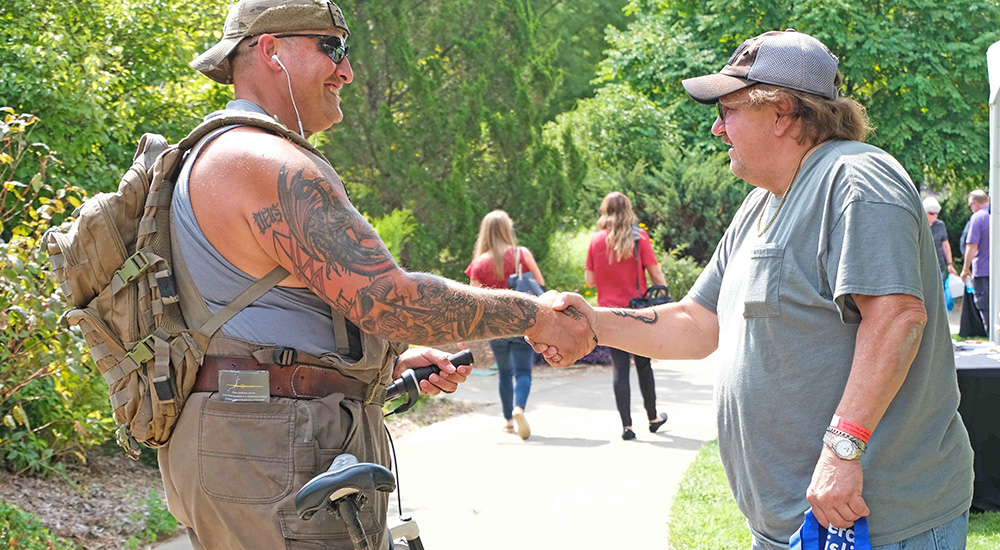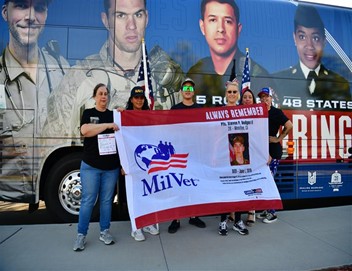On Sunday, March 29, VA Secretary Bob McDonald spoke to the Association of American of Medical Colleges Council of Deans spring meeting in San Diego, California. Below are his remarks.
Good evening, everyone, and thank you for sharing this time with me.
Not long ago, VA Deputy Secretary Sloan Gibson—my good friend and West Point classmate—observed about VA, “There’s simply no other health care system that does as much to shape and influence how doctors and other health professionals think about, and deliver care. None.”
Sloan’s right. But, that’s not VA exceptionalism.
That couldn’t be the case without our collaboration and partnership and shared commitment to excellence in health care: for Veterans, and for all Americans.
We owe that preeminence to great people who went before us—with vision and leadership, courage and conviction.
After World War II, they helped change the way VA delivered care and how medical schools trained and conducted research.
They were physicians like World War I Veteran and University of Cincinnati School of Medicine’s Dr. Paul R. Hawley. Dr. Hawley was Eisenhower’s Chief Surgeon in the European Theater of Operations during World War II.
They were professionals like Dr. Paul B. Magnuson, once VA’s Chief Medical Director. He was also the chairman of Northwestern’s Department of Bone and Joint Surgery, the founder of the Rehabilitation Institute of Chicago, a Fellow of the American College of Surgeons, and a Founding Member of the American Board of Surgery.
Experts like Dr. Michael E. DeBakey, World War II Veteran and Legion of Merit recipient.
And they were great leaders like General Omar Bradley, Administrator of the VA.
In 1946 when General Bradley was leading the VA, 16 million troops were being demobilized, and there were 670,000 casualties of World War II—many on waiting lists at VA hospitals.
General Bradley had an access problem like we can hardly imagine. And the quality of care available for Veterans was unacceptable. Bradley assessed the VA care like this:
“. . . the quality of VA medicine . . . . was not literally ‘medieval.’ . . . but it was—and always had been—mediocre.”
VA was short on doctors. Bradley estimated they were at about 30 percent of what they’d need. And for hiring, their hands were tied by Civil Service that was offering what Bradley described as “the dregs of the medical profession . . . . some doctors on the list had been committed to mental institutions for insanity or alcoholism.” And he couldn’t hire the doctors he wanted without miles of red tape.
A bureaucratic nightmare.
Hawley, Magnuson, DeBakey, Bradley and their teams devised a solution as simple and common sense as it was visionary and revolutionary: establish non-monetary affiliations between VA and medical schools.
And that’s what brings us together today.
Those members of the greatest generation are why VA spends over $650 million annually on medical and nursing school alliances—from Massachusetts General to San Diego.
They’re why about 70 percent of all U.S. physicians received at least some professional training at a VA hospital.
They’re why, together, we train 62,000 medical students and residents, 23,000 nurses and 33,000 in other health fields, annually.
They are why the chief of staff of our Boston VA Medical Center is one of the deans at Harvard Medical School, why the entire faculty at the University of California, San Francisco, medical school is credentialed to practice in VA and all VA’s physicians there are members of the university’s staff.
We pride ourselves on the close collaborative affiliations like that. It’s a source of strength for the VA and for the medical school.
Just this week, Dr. Brian Kwan, San Diego’s coordinator of the third year medicine rotation shared with Jeff Gering, Director of VA San Diego, some unsolicited student observations describing their VA training experience.
Here are a few:
- “The emphasis on teaching was fantastic, and far superior to most other rotations.”
- “The Vets were a wonderful patient population who really allowed us a great opportunity to learn.”
- “The VA is the best place for medical students to work.”
- “I would highly recommend, if not require, students to do at least one of the medicine rotations at the VA.”
- “The autonomy we’re given with patients and the active roles we play in patient care was great for learning. I loved the team atmosphere.”
So, seventy years after General Bradley and his team revolutionized medicine in the United States, the alliances they started sound like they’re in pretty good shape.
In Bradley’s day, the Veterans Administration and its partners could function on a handshake. Activities at VA hospitals were governed and guided by a Dean’s council. Faculty were jointly recruited and moved seamlessly between institutions. And patients received care in the most appropriate environments for their needs at any given time.
But the health care landscape has changed radically, and today, there are major impediments that interfere with the relationships.
Today, because of modern acquisition laws and concerns about conflict of interest, there’s little that can be accomplished with only a handshake.
Shared care now often requires multiple contracts with multiple entities, slowing the process and introducing more opportunity for error.
There’s no one uniform model of an academic affiliate—neither in structure nor in process.
And in a world of hyper-competition, everyone’s scrambling to adapt, to survive, as health care and how we pay for it and deliver it rapidly changes.
For all of us, delivery methods have vastly expanded. For VA specifically, we’re a full service provider with inpatient and outpatient care, remote care and community care.
We provide services from primary care to polytrauma care to complex specialized procedures like organ transplants and neurosurgery.
We employ psychologists, physical therapists, pharmacists, recreation therapists, social workers and a long list of other health care professionals.
We train, educate and provide practical clinical experience for nearly 120,000 people each and every year—and that health care force provides services to many Americans, not just Veterans.
We’re affiliated with over 1,800 of your educational institutions—affiliations that have helped VA make unique contributions in the areas of traumatic brain injury (TBI), prosthetics, post-traumatic stress and other mental health conditions.
VA researchers pioneered modern electronic medical records, the implantable cardiac pacemaker, the first successful liver transplants, the nicotine patch and artificial limbs that move naturally when stimulated by electrical brain impulses.
They demonstrated that patients with total paralysis could control robotic arms using only their thoughts, and they identified genetic risk factors for schizophrenia, for Alzheimer’s, and for Werner’s syndrome, among others.
In 2014, alone, we completed over 55 million appointments—an average of more than 150,000 a day.
So those who fully understand the value of our affiliations in research, training and clinical care understand that Veterans and all Americans need the strong, productive, vibrant relationship we’ve enjoyed for so long.
But we can be better.
Last summer in the early days of VA’s access crisis, former president of the Institute of Medicine Dr. Harvey Fineberg told us, “VA can accomplish things now it never could have accomplished.”
His point: right now, we all have an extraordinary opportunity.
And we’d better take full advantage of it. Opportunities like these don’t come along often.
VA’s strategy to capitalize on this opportunity is called MyVA. It focuses on five objectives that re-orient us on Veteran outcomes, and three of the five are directly related to our discussion today:
- First, indirectly related: improve Veterans’ experience—a seamless, integrated, responsive customer-service experience, every time.
- Second, indirectly related: improve employees’ experience—eliminate barriers to excellent customer service.
- Third, directly related: achieve support services excellence. That means identifying and optimizing common services performed in support of VA mission components where we can increase efficiency and eliminate duplication. Among services we’re targeting relevant to our affiliation are information technology, acquisitions and logistics, legal services, human resources, and budget and finance.
- Fourth, directly related: establish a culture of continuous performance improvement. We want to set conditions at the local level to eliminate impediments and find solutions that can be replicated across as many facilities as needed to achieve enterprise level results.
- And fifth, directly related: enhance strategic partnerships. We want to make better matches between community, nonprofit and other organizations and the work being done for Veterans at VA facilities across the country.
Those are VA’s commitments to Veterans. They’re our commitments to our employees and our commitments to the American taxpayers and their representatives. And they’re my commitment to reinforcing our affiliations.
So we need to get to work and figure out how, together, we can strengthen our partnership and improve education, patient care, research, and take full advantage of this opportunity.
In my view, part of that process will include
- Building a vision of what the VA-affiliate partnership should look like in the 21st century health care delivery system;
- Identifying the specific goals to realize that vision;
- Designing the training systems necessary to support those goals;
- Determining how we can most effectively use VA resources;
- Identifying places where we can forge joint ventures with affiliates to collectively care for Veterans and their families.
And there are many, many more.
We have to put our energy and intellect behind the ideas that are going to make the most difference.
Now, there are some issues that are particularly challenging to the excellence we seek in our affiliations.
We’re too encumbered by laws, regulations, policies and rules related to acquisition and affiliation that slow the pace we need to achieve positive change. That’s everything from Federal Acquisition Regulation to—for our own part—some of VA’s departmental policies and directives.
Our own sole source contracting policies are impeding, rather than promoting, academic collaboration. For our part, we’re looking to see where we can waive specific parts of the regulations and change internal policies to streamline acquisition processes. And we’re looking at what legislative changes might improve contracting with affiliates.
Understandably, standards related to information and data security are becoming more and more stringent. Our task is to figure out how we can protect data while enhancing the free flow of autonomous information that research requires.
When it comes to sharing research data and information, we haven’t been smart about risk management. We have some self-imposed IT policies that are disproportionately burdensome, that don’t fairly balance risk with requirements for productivity, efficiency, and best outcomes for Veterans.
Along those same lines, our research information technology is not invariably cutting edge, and it needs to be—we can’t risk projects like the Million Veterans Program and others because of shortfalls in data availability.
A lot has changed over the 70 years since General Bradley and his team initiated our first affiliations. So if we are going to achieve support services excellence, optimize common services, increase efficiency and eliminate duplication, we have to work through the bureaucracies—that means changing them where we can or seeking necessary legislative changes from Congress.
But in all that we do, in every effort, we cannot forget that our primary objective is to take care of the people depending on us now, and prepare for those we’ll treat in the decades to come.
Thanks for giving me the opportunity to speak; I look forward to your questions and discussion.
Topics in this story
More Stories
VA’s Veteran Buddy Check Week is planned for Oct. 21 – 25, 2024.
Take the stress out of travel. My HealtheVet makes preparing for your time away easy with these five quick tips.
Carry The Load, an organization dedicated to remembering the fallen, will visit 34 VA National Cemeteries traveling 20,000 miles along five separate routes covering all continental 48 states known as the National Relay for Memorial May 2024.







Dear Mr. McDonald: 1April 2015
First of all I want to thank you and your office for helping me get my CROW BOOTS about 3 weeks earlier than they were originally scheduled for. They had been delayed due to a snafu in communication amongst the people at the Iron Mountain VA.
Unfortunately after waiting over 2 months for corrective treatment, my feet became deformed beyond repair and I was offered no alternative to the CROW BOOTS for the rest of my life from the Dr in Iron Mountain. In fact my visit for an evaluation was a complete sham. The podiatrist was supposed to evaluate and help me, but instead this man talked to me briefly after looking at 1 x-ray of 1 foot, when 6 views total were taken of both feet. He never even examined my feet to see how they were progressing or if my diabetes was causing a foot problem that needed attention. His comment was “Oh those compression socks would be awfully hard to put back on. Needless to say I left Iron Mountain looking for a second consult for my feet.
This is what brings me to the occasion to write to you again. I would like you to hear the HIGHEST PRAISES FOR THE GREEN BAY, WI VA HCC.
It is a beautiful facility first off. The atmosphere when I entered the building today was one of friendliness and cheerful helpfulness. The volunteers couldn’t do enough to help me check in and escort me to my appointment in Podiatry. Dr Toutant was friendly and interested in the whole history of the problem with my feet. He apologized for the delay and lack of care from the VA. He very thoroughly explained exactly why my feet broke the way they did and then told me that although my feet would never get any better, that he could my life more comfortable. He told me that this could be done by constructing custom made leather low cut shoe- boots. These would support my feet so that I could walk comfortably. for short distances and would be far more comfortable than the CROW BOOTS. He also gave me a pair of special cushioned canvas shoes to wear in the house when I first got up or when I hadn’t had time to put on the CROWs.
I should be getting my new shoe-boots in about a month and I have a return appointment in 3 months to check how my feet are doing
I also had new x-rays taken of my right foot and the x-ray staff treated me like a very special patient that they wanted to do all they could to help… The x-ray tech heard that we got lost getting there, due to road construction. She went out of her way to make sure we had good directions for getting back out of the city. She also made sure that I got my travel pay taken care of before I left.
I left that facility feeling that I mattered and they were there to make my life as easy and as comfortable as they could.
This is the way every veteran should feel when they go to a VA facility for help.
I cannot say too many good things about my visit today and I would like you to visit what I think is an exemplary VA facility. I have never left a health care facility with such a good feeling that I was in the care of people that care about me. A Medal of Honor to the Green Bay VA HCC.
Thank you again for your concern for me and you help.
Sincerely,
Janet Z Appling
CPT WAC USAR RET
Being a veteran who worked at a VAMC, I know first hand that it takes a special “knack”, a special kind of doctor, nurse, ckerk, etc., to deal with working in the VETERANS Administration environment. Those that put up with some of the crap we veterans out them thru, & hang around for years, truly deserve every perk & benefit they get; IF they do their job. As for those that are there just for a paycheck, & the “executives” that look forward to a big bonus – do the vets a favor & go somewhere else. Those of you that do care & stick around THANKS!!!!
The VA will go to great links to make a veteran look like a liar! They force our veterans to fill our hundreds and hundreds of pages of paperwork. Most veterans have difficulty understanding the complex forms. You must be a lawyer to shovel your way through these pages.
If a veterans forgets every single detail of their military service because years have passed, or the veteran has injures such as PTSD, Traumatic Brain Injury, etc., the VA, led by SECRETARY ROBERT McDONALD, DENIES MEDICAL & COMPENSATION!
When Secretary McDonald lies, saying he was in Special Forces, when he never even saw action, the VA claims he simply MISSPOKE!
Who is the LIAR! Ironic, Isn’t It
Quit worry about these highly paid doctors, nurses and other medical personnel at the VA.
Start worrying about the VETERANS!